UK General Election 2024
Hi Everyone,

The UK General Election has been called for the 4th of July. The UK has a maximum election cycle of 5 years. The previous election was around 4 ½ years earlier, in December 2019. The elections before that were much closer together. There was one in 2017 and another in 2015. These were the Brexit (departure from the European Union) elections. The first was about a possible Brexit referendum. The other two were regarding delivering Brexit or, more likely, the unwillingness to deliver it. Over the nine-year period between 2015 and 2024, there have been five Prime Ministers (David Cameron, Theresa May, Boris Johnson, Liz Truss, and Rishi Sunak). All of them were from the Conservative Party.
I do not vote in elections. I do not believe the system gives us a real choice, nor does it give us any legitimate input into how our country is run. In my posts, The Two-Party Political System – The dictatorship we didn’t know we had and Raise your hand if you live in a Democracy, I discuss how representative democracy is not democracy but instead a form of dictatorship.
Democracy was intended to give the power to the people instead of the elite. This is an unrealistic and naive ambition. I discuss this in my post, Could democracy succeed if it was given a chance?.
We need both a functioning system as well as one that is not controlled by just a handful of powerful people. The process of bringing about meaningful change is long. It needs to be done in steps, and it needs to be gradual.
In my post, What would get me to the ballot box?, I explain in some detail what changes I consider necessary before I become a willing participant. In my post, Blockchain Government – Part 1: Breaking Down the Existing System, I propose how the changes I highlighted in the previous post can be implemented.
Despite not participating in voting, I normally observe the election and the build up to it. Most elections are usually very similar. It involves leaders from the same two parties criticising how bad the other party is while pretending they would solve all our problems. The outcome of the election is normally not important. This election is a little different. It might lead the UK on the path to permanent change. Ironically, it has little to do with the party that will inevitably win.
Two Party System

The UK has several political parties, but only two major parties have any chance of winning an election. Therefore, we can consider that the UK has a two party system. This system is reinforced and protected by the first-past-the-post voting system. The system causes votes to converge on just two parties. This is because people can only vote for one party (i.e., does not allow for ranking parties). If there are two similar parties, people are more likely to vote for the bigger party than the smaller party. This unifies the votes of people who believe in a similar ideology, thus giving them a better chance of winning.
Imagine there are three parties. Parties A and B are similar, and Party C is very different. If people voted based on which party they preferred, the vote split might be 35% for Party A, 20% for Party B, and 45% for Party C. Party C would win. However, if the voters who prefer Party B switched to voting for Party A, Party A would obtain 55% of the vote and win. Such a result would prevent Party B from ever having a chance of winning.
In recent elections, for many of the seats, the strategic move of uniting the vote has increased further with the use of tactical voting. The Labour, Liberal Democratic, and Greens Parties have an informal pact to vote for the party candidate most likely to win that seat. Therefore, votes could largely consolidate behind just one candidate, and the other two candidates would receive very few votes. This is done to reduce the chances of the Conservative Party candidate winning. This could stop the Conservative Party from obtaining a majority and, if necessary, help Labour form a coalition government. In Scotland, it appears the Greens voters are willing to tactically vote to help the SNP; see matrices below.
Figure 1: Tactical Voting
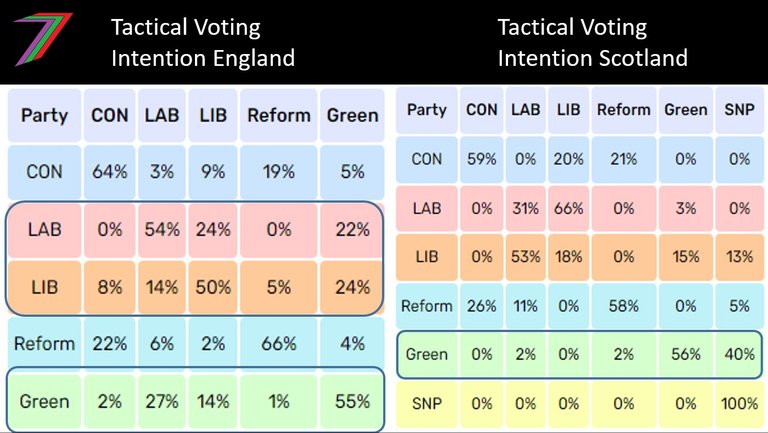
Source: Electoral Calculus
Possible Changing of the Guard
For over a century, the Conservative and Labour parties have dominated UK politics. This occurred when Labour displaced the Liberals as the other party in the two-party system. Once displaced, the Liberals were unable to win another general election (Wikipedia). This demonstrates how important it is for a party to be in the top two.
It is possible that the dynamics of UK politics is about to change again. This time, the Conservative Party is in peril. After former Prime Minister Boris Johnson was ousted for eating cake (The Guardian), the popularity of the Conservative Party plummeted and has remained very low ever since. See Figure 2 below.
Figure 2: UK Voting Intention Trends (2020 to 2024)
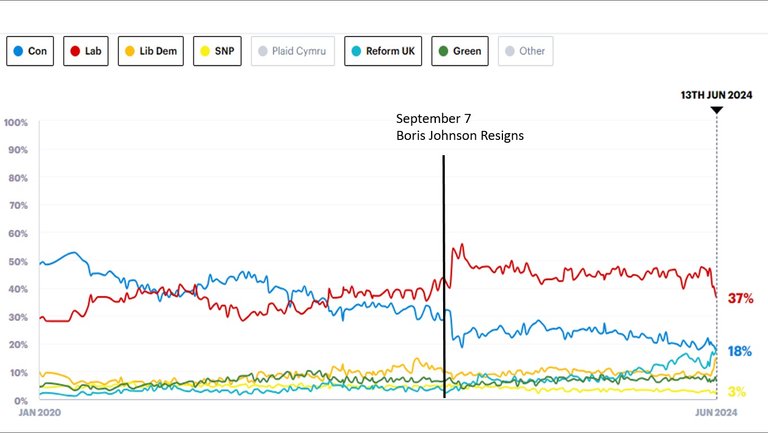
Source: YouGov
Polls can be wrong. However, Labour has been consistently ahead by around 20 percentage points in all polls for the past two years. It is highly unlikely that all the polls have been consistently wrong for such a long period. For the Conservative Party to win, support for the Labour Party would have to catastrophically crash.
Incredibly low popularity is not the Conservative Party’s only problem. Another party has gained considerable ground on them. This is the Reform UK Party. What makes Reform an electoral threat is that they are supporting and suggesting policies that align with what many Conservative voters believe the Conservative Party should be pursuing (i.e., they align more with British conservatism and capitalism). Therefore, the majority of Reform’s support comes from former voters for the Conservative Party. We can see this change in support based on the voting intentions of those who voted for Conservatives in 2019 as well as those who voted for Brexit.
Figure 3: 2019 Conservative Voters Voting Intentions in 2024
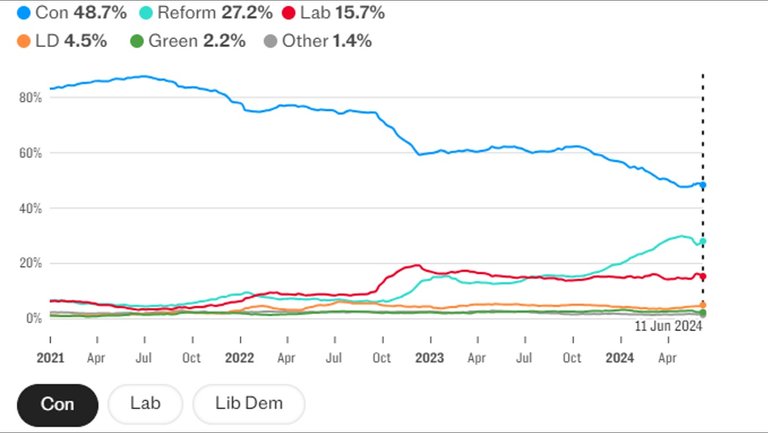
Source: Telegraph
Figure 4: Brexit Voters Voting Intentions in 2024
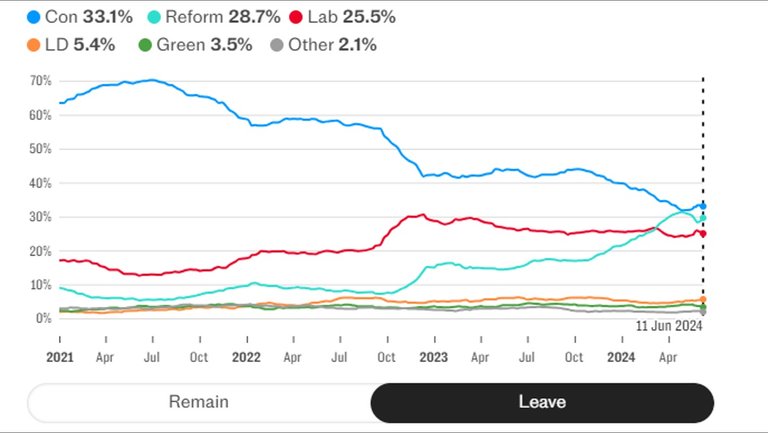
Source: Telegraph
The conservative voting base is split between the Conservative and Reform UK parties. In any other general election, the majority of voters would end up voting for the Conservative Party because that would give them the best chance of stopping the Labour Party from forming a government. This is far less likely to happen in this election. Many Conservative and former Conservative voters do not believe their party can win. This greatly reduces their incentive to vote for them. Therefore, they are more likely to vote for another party that will better represent their beliefs. See Figure 5 for the percentage of Conservatives who believe the Conservative Party will form the next government.
Figure 5: Conservative Voters Who Believe the Conservative Party Will Form the Next Government
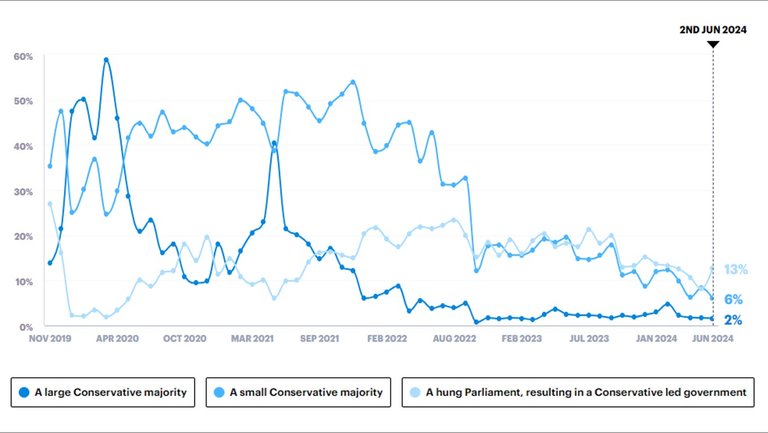
Source: YouGov
The majority of Conservative voters disapprove of the Conservative Government’s performance. Therefore, they are less inclined to continue voting for them, see Figure 6 below.
Figure 6: Conservative Government Approval Ratings Among Conservative Voters
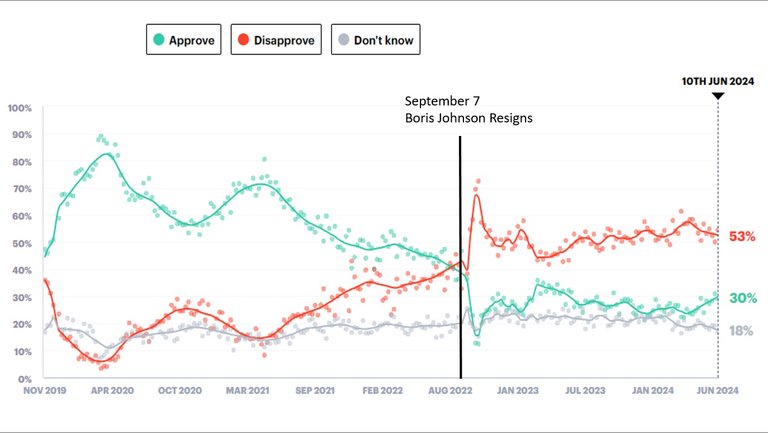
Source: YouGov
This disapproval appears to be growing as the Prime Minister, Rishi Sunak, keeps drawing negative attention. He created a bad impression by calling for the election in rain, proposing National Service, and leaving the D-Day commemoration early. It is as if he is intentionally trying to lose the election.
Former Conservative voters are also not strongly inclined to switch to voting for the Labour Party, as approximately half of Conservative voters consider the two parties to be similar (YouGov Survey). Therefore, they would believe they are more or less voting for the same thing. The perceived similarities between the two parties would also reduce the desire to stop Labour because the perceived net decline would be minimal.
Votes But No Seats

The setting is viable for a massive vote swing from the Conservative Party to another party that better represents the ideology of typical Conservative Party voters. The party that serves that purpose is Reform UK; other alternative parties are very similar to the Labour Party (discussed later in the post).
Reform UK might be a relatively new party, but the leader, Nigel Farage, is well established in politics. He previously led the UK Independence Party and the Brexit Party. He was also a member of the European Union Parliament for over two decades. His beliefs have been consistent throughout his political career. He consistently supported and advocated for the UK to leave the European Union. He has consistently supported British conservative values, free market operations, and limited government intervention (High Profiles). He has both experience and credibility. Therefore, voting for his party is less of a risk than voting for a party that is completely new in terms of leadership. Nigel Farage is also friends with Donald Trump. He has a closer relationship with Donald Trump than any other UK party leader. Some voters would deem this important, as Donald Trump could become the next president of the USA.
The biggest obstacle to the Reform UK Party becoming one of the top two parties is the first-past-the-post system. In seats that the Conservative Party is still favourites to defeat Labour in, Conservative voters are less likely to switch to voting for Reform UK because that would likely hand the seat to the Labour Party. Conservative voters are more likely to switch to Reform UK in the seats that they have given up on. Unless, Reform UK can win over some Labour voters in these seats, they are likely to fall short. It is quite possible we could have the perverse outcome that Reform UK wins more votes than the Conservative Party, but ends up with a fraction of the number of seats.
Below are the breakdowns of the seats each party could win based on a recent seat projection by YouGov and a poll by Electoral Calculus.
Figure 7: Number of Seats Predicted to be Won by Each Party Based on the YouGov MRP Prediction Model
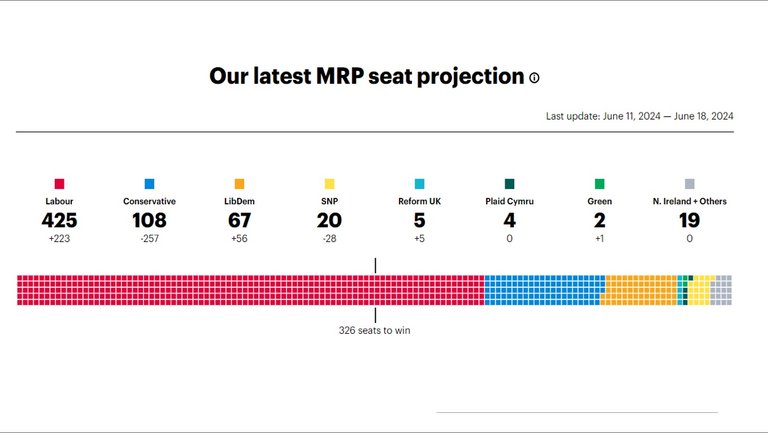
Figure 8: Number of Seats Predicted to be Won by Each Party Based on the Electoral Calculus 14 June Poll
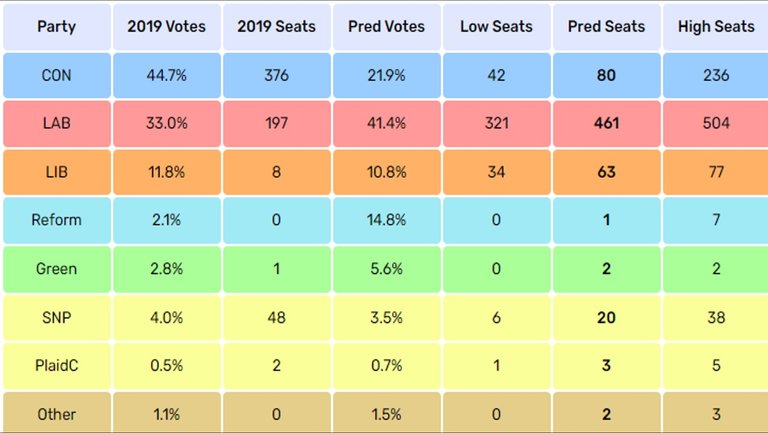
The Electoral Calculus is not the most optimistic poll for Reform UK; they are around 7 percentage points behind the Conservative Party. The most optimistic poll for Reform UK (as of 17 June), is the YouGov Poll shown in Figure 2. In this poll, Reform UK leads the Conservative Party by 1 percentage point. The Electoral Calculus website allows users to enter their own figures into their seat predictor. In Figure 9, I entered the more optimistic YouGov poll results into the predictor.
Figure 9: Number of Seats Won by Each Party Based on the 13 June YouGov Poll
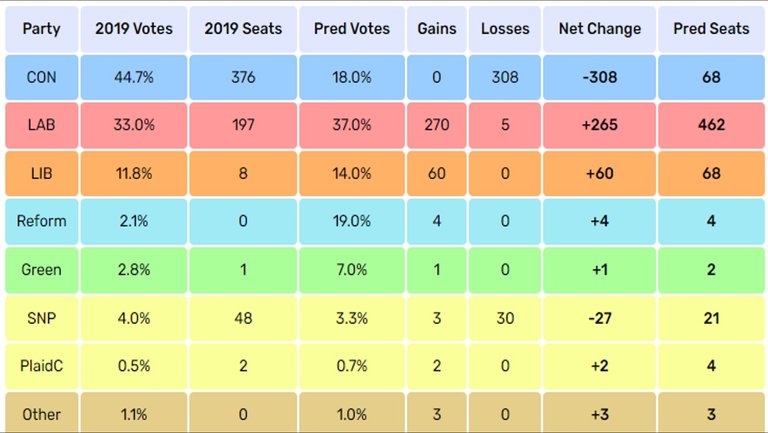
Source: Electoral Calculus
Reform UK would only win a meagre 4 seats. Ironically, the splitting of the vote could lead to the Liberal Democratic Party overtaking the Conservative Party instead. This result would likely enrage many of the voters. It would leave a very big question mark around who the opposition really is. In my post, The Power of Opposition in the Face of Growing Tyranny, I discuss the importance of opposition to the Government.
What would happen if Reform UK’s popularity continued to increase? This will depend on how much and to whom they take the votes off. Below are several possible scenarios that I have played out using the Electoral Calculus seat prediction tool.
- Reform UK takes 2 percentage points from both Conservative and Labour Parties.
- Reform UK takes 3 percentage points from both Conservative and Labour Parties.
- Reform UK takes 6 percentage points from the Conservative Party.
- Reform UK takes 6 percentage points from the Labour Party.
- The Labour Party loses 6 percentage points to Reform UK and 3 percentage points to the Liberal Democrats.
Rationale for scenarios taking votes from Labour: Percentage points taken from the Labour Party are most likely to come from Conservative Party voters who recently switched to Labour out of lack of choice and a resurgence in turnout from former Conservative voters who believe Reform UK is a viable option.
Figure 10: Reform UK takes 2 percentage points from both Conservative and Labour Parties.
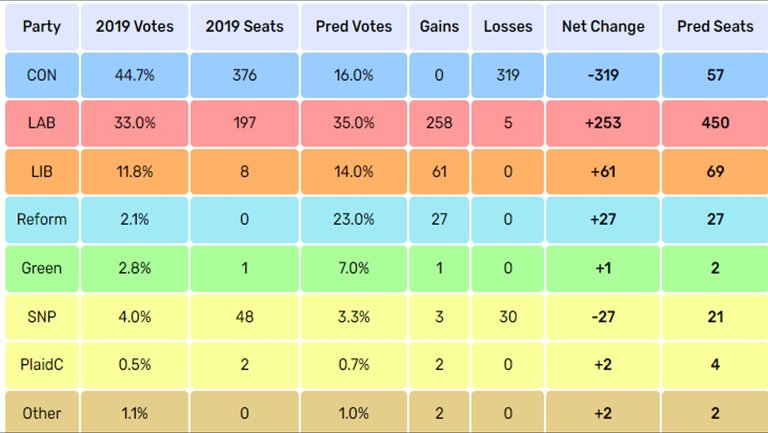
Source: Electoral Calculus
Figure 11: Reform UK takes 3 percentage points from both Conservative and Labour Parties.
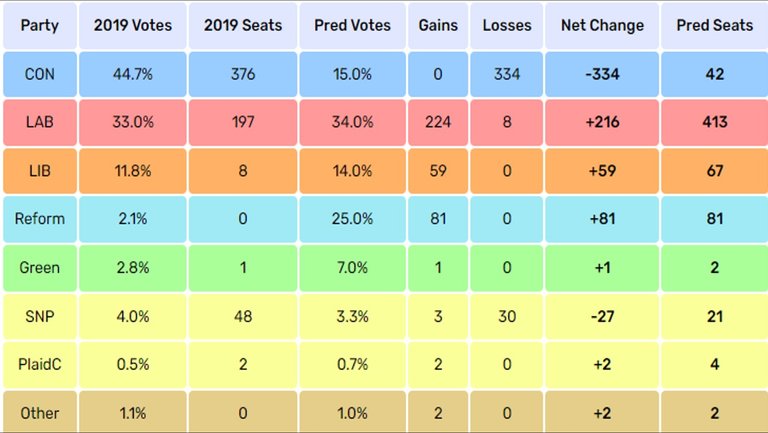
Source: Electoral Calculus
Figure 12: Reform UK takes 6 percentage points from the Conservative Party.
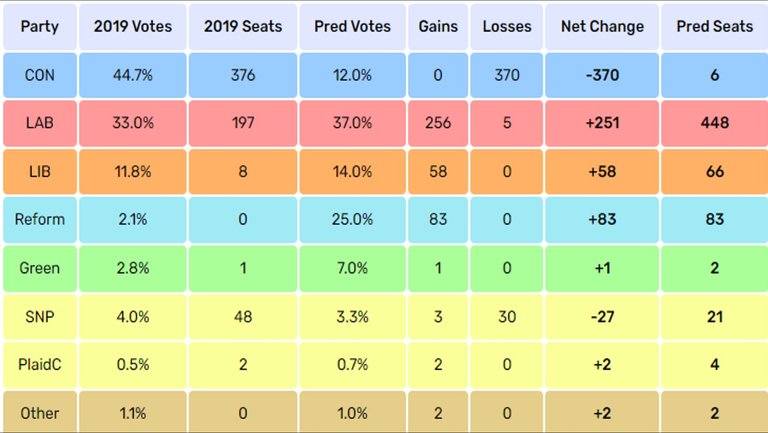
Source: Electoral Calculus
Figure 13: Reform UK takes 6 percentage points from the Labour Party.
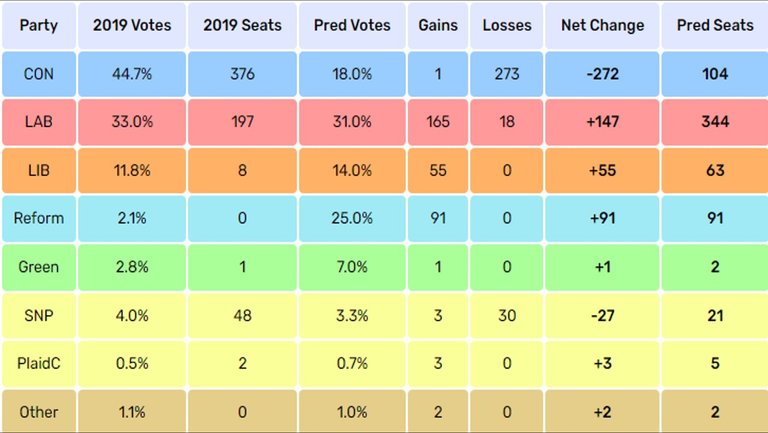
Source: Electoral Calculus
Figure 14: The Labour Party loses 6 percentage points to Reform UK and 3 percentage points to the Liberal Democrats.
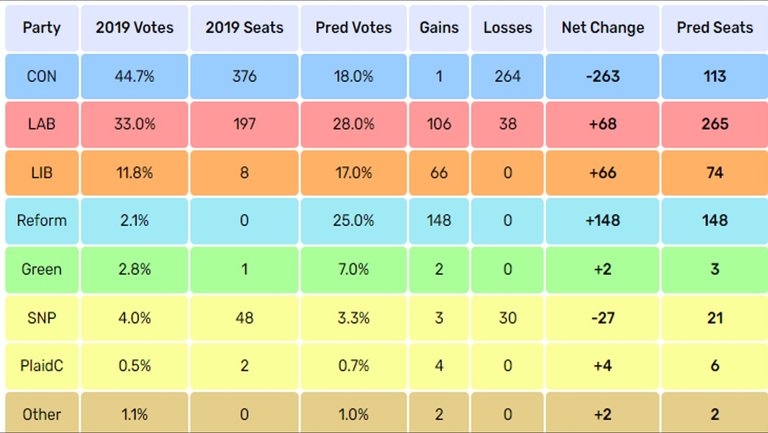
Source: Electoral Calculus
In three of the five scenarios, Reform UK would obtain the second highest number of seats. In all three of the scenarios, Reform UK would need to obtain at least 25% of the vote. In two of those scenarios, Reform UK would still need to take votes from the Conservative Party. In the other scenario, the Labour vote would need to collapse. This would force them into a coalition with the Liberal Democratic Party. If Reform UK vote share increases but falls short of 25%, ceteris paribus, the Liberal Democratic Party would become the favourite to obtain the second highest number of seats.
The Electoral Calculus predictions assume percentage changes in votes are consistent across all seats, which is highly unlikely. It also did not include tactical voting, which could have a large impact. Both of these limitations are likely to exaggerate the number of seats that Reform UK would obtain and underestimate the number of seats the Liberal Democrats would win. A continuing surge from Reform UK is likely to result in the Liberal Democrats becoming the opposition party for the next election cycle. Even if Reform UK support continues to surge, they may not even obtain ten seats.
If the Liberal Democrats become the official opposition, it is highly unlikely that the public will perceive them as the real opposition. This would be because they are even more similar to the Labour Party than the Conservative Party. We know this because of the voters’ willingness to tactically vote. The Liberal Democrats would also become the opposition party with only the fourth highest number of votes. The two party system would look broken. Even if the Conservative Party becomes the official opposition party, they would do so by obtaining a disproportionately high number of seats compared to the Reform UK Party, which is likely to have a similar or higher share of the vote.
The overwhelmingly likely outcome of this election is a huge Labour majority, possibly as high as 70% of the seats. This would be the case even if they obtained less than 40% of the vote. The opposition party might have less than 20% of the vote, and if it is the Liberal Democrats, it could be less than 15% of the vote. It is possible that 40% of those who have voted in the election will have little to no representation. This would be particularly true for those who voted for Reform UK.
Death of First-Past-The-Post

Designed using Bing AI created Images
These results would highlight the unfairness and undemocratic nature of the first-past-the-post electoral system. Nigel Farage, who is one of the more likely Reform UK candidates to win a seat, will actively campaign to change the first-past-the-post system. His campaign will receive considerable attention from mainstream media such as GB News and Talk TV.
The Liberal Democrat Party would likely be sympathetic to such changes since they have been consistently underrepresented in past elections. The Labour Party is likely to resist change considering how the two-party system has benefited them. However, this resistance is unlikely to be strong considering that Labour has previously proposed changing the first-past-the-post system (see my post, What would get me to the ballot box? (Discussion on possible Labour Party proposals)). The Conservative Party is likely to show the most opposition to it because it has benefited them the most.
I predict there will be a referendum regarding the-first-past-the-post system. This could come as soon as the next election cycle, or it might be included in the manifestos of parties for the next general election. The referendum could be done in many ways. It might be a simple yes-or-no question asking if people want to keep first-past-the-post, or it might include alternative voting systems such as preferential voting or proportional representation. Either way, there is likely to be little detail about what exactly the alternative would be. There are dozens of models of preferential voting and proportional representation (see my post, First-Past-The-Post Vs Preferential Voting Systems). The details would be determined after the referendum.
A different voting system could still support a two party system, but it is far less likely than the first-past-the-post system, which ensures it. It is more likely to create a two ideology system of ‘left’ and ‘right’ where the parties of the winning ideology form government. Ideally, we would want a multiple ideology system where different ideologies are not just represented in parliament, but also in government. There is more likely to be cooperation between several groups of people with different ideas than between two groups who want to create the perception that they diametrically oppose each other.
How Did UK Politics Land in Such a Position?
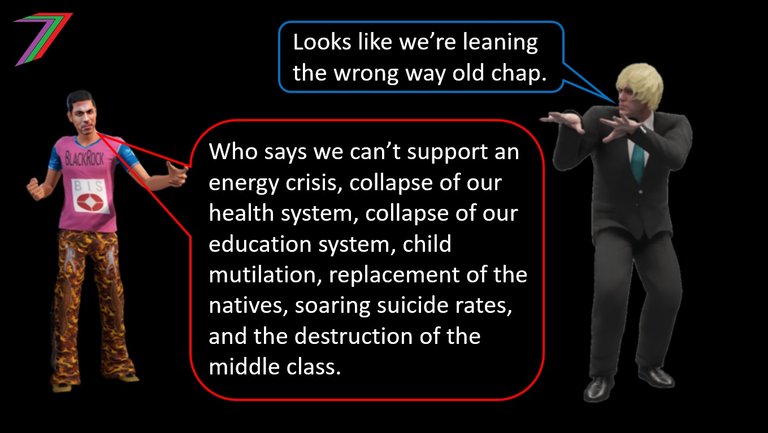
UK politics have been a little out of sync with the rest of the western world. The Conservative Party has been in-charge of the UK since 2010. They are supposed to be a conservative right-wing party. However, during this time, most western countries have had governments that claim to be left leaning, liberal, or centrist. Centrist views on the warped left-right political paradigm align more closely with claimed left views. We could argue that none of these governments are actually left (see my post Is Socialism being used as a path to Fascism? for a more elaborate discussion on this topic).
Many of the strange ideologies relating to wokeism have been aligned with left or liberal politics. The UK has not had a government that has claimed to be left-leaning or liberal. We could argue that the British left leaning parties’ opposition to Brexit has kept them out of Government. Whereas, during the elections that followed the referendum, the Conservative Party united the Brexit vote under them. The first-past-the-post system worked in their favour. Even though the Conservative Party confidently won the 2019 general election, if it had been held under a proportional representation system, Labour may have formed a coalition government (see my post, What would get me to the ballot box? (Discussion on possible Labour Party proposals) for a rough comparison of actual and possible results under proportional representation).
In order not to fall behind in pushing the woke agenda, the Conservative Party enabled its growth by not contesting its spread through the media and grassroots organisations. This has led to a wide variety of problems.
The Conservative Government also implemented lockdowns, which caused enormous harm to the economy. They borrowed excessively to pay for furlough schemes. They used taxpayer money to buy jabs that have caused more harm than good. They have destroyed the health system by enabling gross inefficiency. They funded a war against Russia. They supported sanctions that caused fuel prices to soar and caused high inflation, which led to the cost of living crisis. They supported ‘net zero’ carbon policies that further weakened energy security. They enabled both legal and illegal mass immigration. All of the above are more consistent with the self-proclaimed left leaning parties of the western world.
A growing number of people in the western world have realised how these left leaning parties are destroying their countries in almost every way imaginable. The response has been to switch support to parties that are pursuing policies that align more closely with conservative values. These parties are branded as far-right or hard right by the media (Politico). We have seen this surge in the USA with the popularity of Donald Trump. In Europe, with recent European Union elections (Politico) and before that, with elections in the Netherlands, Italy, Finland, and Sweden. The self-proclaimed left-leaning and centrist parties in France, Belgium, and Germany are losing support to parties that support conservative values and policies (often referred to as far-right by the media).
Many people in the UK share the same sentiment as people from the rest of the western world. However, their so-called Conservative Party is very similar to their self-proclaimed left-leaning Labour Party. The only way to remove the pretend Conservative Party is to replace them with the self-proclaimed left leaning Labour Party. The Labour Party will promote the strongly disliked policies that the Conservative Party is enabling. Ironically, people will be voting to fast track all the things they do not want. There is an absence of any real opposition, and that has become obvious to many people. As it becomes apparent that democracy in the UK is a farce, the closer the country gets to civil unrest.
The start of the proposed solution is Nigel Farage and the Reform UK Party. His job is to represent the people who are deeply disgruntled with the two major parties. He and the Reform UK Party are the controlled opposition. His job is to focus on the symptoms of all the deeper problems. These include woke ideology, mass migration, national sovereignty, failing healthcare system, high taxes, energy security, the cost of living crisis, erosion of family and values, education, and crime.
Targeting the symptoms is also likely to turn people against each other. Nigel Farage strongly focuses on mass immigration. If insufficient emphasis is placed on the causes of mass immigration, division between migrants and the citizens of the UK is likely to grow. There will be a perception that the new migrants are to blame for the problems that can be easily linked to them.
After the general election, this focus is likely to switch to attacking the first-past-the-post system, which most likely will leave Reform UK vastly underrepresented in parliament.
Reform UK is unlikely to challenge the deeper underlying problems. These might include the extent of control the banking and financial system has on us, the dominance of big business, the UK’s unwavering support of US foreign policy and ‘forever wars’, big pharma’s grip on healthcare, stagnating real wages and income of the middle class, real problems with the education system, widespread corruption in politics, and mainstream and social media propaganda. Reform UK’s focus is to bring back the nostalgic years before we were bombarded with the madness of the past decade.
The next step of the solution is to replace the first-past-the-post system. It has become obvious that first-past-the-post is deeply flawed. It needs to be replaced. However, it should be replaced by something that offers a vast improvement. This is highly unlikely to occur. The most likely scenario is that it is replaced by a proportional representation system similar to the ones in Europe.
The electoral map would need to be redrawn to accommodate multiple members of parliament. This reduces contact with and accountability to the constituents. Proportional representation can be used to protect and ensure certain politicians always win a seat. Proportional representation is party-focused. It is harder for independent candidates to win seats. Proportional representation can lead to extremist groups becoming power brokers in close elections (e.g., possible backdoor to introducing elements of Sharia law).
Which Works Better for the Establishment?

The first-past-the-post system has served the Establishment incredibly well. It has provided the illusion of choice while maintaining almost as much control as a dictatorship or oligarchy. However, it lacks flexibility. If a significant portion of the population realises that the two major parties are too similar, it is close to impossible to insert another party to replace one of them. This means one of the two major parties needs to appear dissimilar. This can be very difficult if the party has lost credibility.
The USA managed to create the appearance of credible change by using Donald Trump. This was only possible because they have a presidential system that enables outsiders to be inserted as leaders. This is considerably more difficult in a parliamentary system, which is more closely integrated and party leadership is more tenuous.
Proportional representation provides far greater flexibility, as governments are typically coalitions of parties. The composition and influence of parties in a coalition can be changed easily. Voting for a different party within that coalition is unlikely to hurt the chances of that coalition remaining in Government. For example, a coalition could shift from 70% Conservative Party seats and 30% Reform UK Party seats to a 50-50 split. The added flexibility of a proportional representation system can enable the Establishment to quickly stoke controlled division among the masses.
The main disadvantage of proportional representation to the Establishment is a possible loss of complete control over parties. It is easy to control two major parties. It is more difficult to control numerous parties. Proportional representation creates opportunities for anti-establishment parties to win seats. The Establishment needs to ensure these anti-establishment parties do not become part of the Government or become power brokers.
Nature of the Political Parties in the UK

The convergence of the ideologies of the self-proclaimed left leaning and the self-proclaimed right leaning parties is not a new phenomenon. The differences between them have been slim for decades. People did not notice because it was a gradual convergence. What has changed is the rapid growth of radical ideology promoted by the self-proclaimed left-leaning and centrist parties. The decision of the Conservative Party to enable and, in some cases, support the growth of this ideology highlights how similar the parties from ‘both sides’ of politics are.
The idea that politics runs on a left-right spectrum is ludicrous. What is left, and what is right? Apparently, it is whatever the major parties say it is. A single axis is useful for creating the illusion of difference because it oversimplifies the differences between parties.
The political spectrum is far more complex than a single axis. It consists of multiple axes. I have discussed this in previous posts. They were Exploring the Political Spectrum (Octagon Model) and Applying the Octagon Model to the Political Spectrum. If we apply a multi-axes political spectrum to compare UK political parties, it becomes obvious how similar the two major parties are, as well as most of the other self-proclaimed left leaning parties. See Figure 15 below.
Figure 15: Octagon Political Spectrum Comparing UK Political Parties

Note: Placement of parties is based on current and past manifestos as well as general emphasis and actions taken by the parties.
Five parties are very similar. They all strongly lean towards globalism and authoritarianism. The only slight difference is how far they lean towards collectivism. The Green Party leans the most towards collectivism and the Conservative Party the least, but even this difference is minimal.
The Reform UK Party can be seen to be noticeably different on this spectrum. They strongly favour nationalism over globalism and individualism over collectivism. They promote themselves as supporting freedom in terms of free speech. However, they have hinted towards leaning to an authoritarian approach towards immigration, education, and crime. It is quite possible that Reform UK could become considerably more authoritarian if it obtained any significant authority.
I have also included the Workers Party of Britain, led by George Galloway. The Workers Party of Britain more closely aligns with traditional left leaning ideology. The party supports nationalism and collectivism. George Galloway appears to lean towards order rather than freedom. He has shown admiration for several dictators (e.g., Vladimir Putin and Xi Jinping). His values tend to be conservative, such as advocating for traditional family structures and hard work. Therefore, we could argue that his party might sit somewhere between a moderate form of Marxism and Egalitarianism.
The Workers Party of Britain is not particularly popular. However, George Galloway has gained significant support from the Muslim communities based on his anti-Israel stance. It is possible his party could win a few seats based on the clustering of these communities in certain constituencies.
Final Thoughts

Barring some extreme unforeseen events, the 2024 UK General Election has been decided. The most likely outcome is an overwhelming victory for the Labour Party.
The more important aspect of the election relates to who comes in second. This relates to second-place in seats as well as second-place in votes. The Conservative Party is most likely to obtain the most seats and votes, but that could easily change if support for the Reform UK Party continues to grow. This could cause the Liberal Democratic Party to win more seats than the Conservative Party, even though they might have fewer votes than either the Conservative Party or the Reform UK Party.
The Reform UK Party would need a huge surge in support to become the official opposition party. Thus, it is highly unlikely they will become the second party in terms of seats, even though they have a strong chance of becoming the second party in terms of votes.
I believe the main outcome of the general election will be the undeniable exposure of the first-past-the-post system, which will lead to its destruction within the next five years. The push will be to replace it with a proportional representation system, which will be marginally better than first-past-the-post but will ultimately lock us into a two ideology party system.
The collapse of the first-past-the-post system offers us an opportunity to shift to greatly improved voting and political systems. The weaknesses of a political system revolving around parties need to be pushed to the forefront. Therefore, a voting system and a political system can be developed around the representation of the people of each constituency. A parliament of independent candidates could replace parties. A preferential voting system such as a Condorcet or Borda count system could be used to facilitate the fair election of such candidates.
Other Posts Relating to Political Systems
- Are the ‘right-wing’ hijacking conspiracy theory to maintain the two party system?
- Political Systems and Freedom
- Faces for the Faceless
My New Book, Sapien Loop

I have published an ebook on Amazon; it is titled ‘Sapien Loop: End of an Era’. The book is fiction. I do not normally write fiction. However, I felt it was appropriate considering what is happening in the world today. Freedom is the most important thing we have, but we are gradually losing it. I have covered this in many of my posts.
In the story, most citizens do not understand the concept of freedom because they have never really experienced it. In essence, the story is about an alien world that might represent our not-so-distant future. There are many other elements to the story that are an abstract and exaggerated version of our reality. I believe this book to be an important read, and I believe it has the potential to change the way you think.
Brief Summary of Sapien Lopp

This story is based on the fictional planet Sapia and its sole country, Sapey. Sapey is portrayed as a form of utopia for all its citizens. No poverty. No war. Almost no crime. Opportunities for all.
This was enough for most citizens, but not all. In one of the small regions, some of the citizens had become discontent. They felt something important was missing in their lives. Their discontent did not go unnoticed. Some of the Sapey elite wanted to weaponise this discontent to gain more power. This created more chaos than they anticipated. This led to further widespread social unrest.
On top of the chaos, ambition and greed provoked another enemy. This enemy was on a mission to settle both new and old scores.
If you want to buy a copy of the book, below are links to the relevant Amazon websites for each country it is available in. The book is priced at approximately US$5.08.
- Amazon USA
- Amazon UK
- Amazon Germany
- Amazon France
- Amazon Spain
- Amazon Italy
- Amazon Netherlands
- Amazon Japan
- Amazon Brazil
- Amazon Canada
- Amazon Mexico
- Amazon Australia
- Amazon India
I am also running monthly contests where participants are required to answer questions based on the book. The prize is 30 Hive Power plus upvotes for the first twelve entries. You can recover the cost of the book with just one win.
Hive: Future of Social Media

Spectrumecons on the Hive blockchain

I totally get your frustration with the current political system brother. It feels like no matter who you vote for, shit stays the same. Maybe real change needs a completely new approach. Infact I'm about to post a blog in this in a couple minutes
The results of the election might change the path a little but the long run outcome is the same. We saw that in the US with the Trump presidency followed by the Biden presidency. For there to be meaningful change, the system needs to change.
That's so deep and so true for there to be actual meaningful change the system itself needs to change. Thanks for this brother
At the end of the day, all these are just predictions and calculated guesses...
The conservative party could still come up and get it.
I wonder how that'll look for the UK economy...
Does Trump have a chance for presidency?
With all these cases piled against him?
The worst outcome would be a typical outcome; i.e., two party dominance. In this case, it would be Labour winning reasonably comfortably and the Conservatives winning most of the remaining seats.
A better but very painful outcome would be complete Labour domination with no real opposition. We would have a plutocratic socialist dictatorship. An obvious dictatorship wouldn't last for long in the UK. An opposition would rise. Where it goes from there is uncertain. The UK is definitely on the path to destruction. It's more important to focus on how to position the country so it can be rebuilt.
Trump has a great chance to become president. He is very popular and the court cases are helping his popularity. Things could change very quickly, it depends who replaces Joe Biden. I think Gavin Newsome is the favourite, but I think it'll be Michelle Obama. I predict Michelle Obama would beat Trump. She would bring out the hardcore Democrat voters. This could be enough if we include the 'mail-in' voters.
Didn't even know Mitchell was an aspirant....
"I find your study of representative democracy's shortcomings and the UK's two-party system to be rather thought-provoking. Gradual changes are necessary for meaningful change, and your suggested Blockchain Government is an interesting way to go." 👏🗳🌟
Thank you. Your comment highlights many important points.
Congratulations @spectrumecons! You have completed the following achievement on the Hive blockchain And have been rewarded with New badge(s)
Your next payout target is 88000 HP.
The unit is Hive Power equivalent because post and comment rewards can be split into HP and HBD
You can view your badges on your board and compare yourself to others in the Ranking
If you no longer want to receive notifications, reply to this comment with the word
STOPKeep up the good work. 👏
Recognized by Mystic artist Gudasol
You are loved.
Interested to to help music map cXc.world spread more good vibes on Hive?.